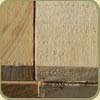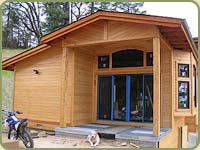
Port Orford Cedar
Port Orford Cedar (POC) is a truly unique cedar species which has a light colored wood, allowing it to stain uniformly. Its fine texture, straight grain, and pleasant, sweet-spicy scent make it an excellent choice for interior applications and woodworking.
Decking made from POC is not only strong, its safe for children, pets and people of all ages. The surface texture of this cedar remains smooth with no raised grain or splintering, and its durability makes it ideal for use in high-traffic outdoor sites and exterior applications.
Strength, durability and natural decay-resistance make Port Orford Cedar the ideal wood for timber structures.
Scientific Name: Chamaecyparis lawsoniana, it is renowned for its beauty and structural integrity, useful for both indoor and outdoor uses. Other common names: Hinoki, pacific white cypress, oregon cypress, pacific white cedar. Read more below…
Lumber Sizing
If you need a particular net size of material, please be sure to make your sales representative aware of the exact net size so he can provide you with the right piece of lumber.
Available Board Grades





Note the different colors above (some boards have been finished).
Port Orford Cedar, like any other wood, has a range of colors. On special orders we are able to match colors at an extra cost.
- cv – Clear Vertical Grain – Pieces may exhibit a few minor characteristics which do not detract from their high appearance and quality. Limiting provisions include: very light torn grain, very light skips on the non-graded face and very light warp.
- c – C & Better Clear – Pieces of this grade are of sound wood.Ý Most pieces are entirely clear or have only a few unimportant characteristics such as: medium stained sap wood , short splits in not more than 5% of pieces , small pitch streak or a smalPieces of this grade are of sound wood.
- d – D and Better Clear – This grade accounts for pieces of lumber having one or more characteristics which are of such size and number that the piece is not of C & BTR grade. Medium pitch streaks, limited pin holes, hit and miss skips, two knots approximately 1″ or their equivalent.
- tk – Select Tight Knot – The basis for this grade are the knots, burls and naturally occurring markings which are of fairly uniform distribution and add to the decorative character of the piece. Sound, tight knots: star checked and/or slightly chipped knots permitted.
- bt – Standard and better – The visual quality takes precedence over the structural integrity of a particular piece of lumber. grain density, coloration and clarity of the exposed face is key to selection.
***Knotty grades are used primarily on housing and light construction where wood is exposed for its beauty and character. The lowest grades are useful in applications where economy is the basic requirement.
Available Patterns
Tongue & Groove , Channel , Pattern 105 , Edge & Center Bead , S4S
Port Orford Cedar Products in Application
Enjoy this rare wood for for exclusive projects, see why this wood has a cult following.
Browse our line of products below, or browse by species on the lumber species page. We aslo have a Raw Lumber Picture Gallery.
If you don’t see what you are looking for don’t hesitate to email us and request a custom job.
Siding
Decking

Covered or uncovered, exterior decks make an awesome addition to any home, or business!
One of the finest and rarest wood available due to the limited growth range, this species is a highly sought-after material. It's resistance to moisture and rot makes it ideal for decks and outdoor applications. It's also a great choice for humid, wet climates for these same properties. Learn more about Port Orford Cedar Siding Here.Post and Beam
Port Orford Cedar post and beam lumber provides a structural and visual treat for any builder, remodeler or homeowner
This species of lumber provides a beautiful, rich color and warm atmosphere in any building. Pergolas, trellis, timber frames, arbors and garden structures made of Port Orford Cedar feature an extended life compared to other softwoods. Don’t forget to get a quote for your next project! You won’t be disappointed.
Interior Paneling and Ceiling Paneling
Port Orford Cedar makes a wonderful interior paneling or interior ceiling option.
As you can see in the photos below, this wood starts out with a light or creamy color that will age naturally over time into deeper hues of the starting shade unless you apply a finishing product to it that alters the colors. Also shown below are exterior soffits in a clear grade.
For technical information on Port Orford Cedar see this page, or the POC species page for more general info.
Boards

Boards
Soft tones of yellow, white and light pink set this wood apart. A wide variety of sizes and lengths in stock, plus special order items.
Port Orford Cedar Products Chart
| Post and Beams |
|---|
| Surfaced Four Sides S4S - Special Order |
| Rough Cut |
| Free of Heart Center (F.O.H.C.) |
| Boards |
| Surfaced One Side and Two Edges (S1S2E) |
| Surfaced For Sides (S4S) |
| Rough Cut |
| Paneling and Patterns |
| Tongue and Groove |
| Double Flush |
| Channel |
| Beaded |
Characteristics Of Port Orford Cedar
Density(oven-dry): 30pcf
Specific Gravity (oven dry): 0.36
Durability: It is rated as resistant or very resistant to heartwood decay.
Finishing: The heartwood is moderately resistant to preservative treatment, while the sapwood is permeable.
Working Properties: Port-Orford-cedar works well with tools.
Port Orford Cedar has earned a reputation for strength and decay-resistance.
Like all cedars, it is a member of the cypress family and this species in particular is a particularly hard and strong, with the same natural durability as other types of cedar when it comes to weather, rot and insects.
Historically, as the strongest of all the cedar products it has been the preferred wood for japanese architecture, building boats, railroad ties and fence posts (its heartwood has an in-ground life of 20-25 years by the Oregon State D.O.T.).
Beautiful Color and Appearance:
In color, Port Orford is a lighter shade than Red cedar or Redwood .The color can also be described as a creamy white hue, and it ages to a stately silvery gray. This brand of cedar remains smooth with no raised grain. Due to the pale nature of its coloring, it gives unlimited options when staining.
The wood dries easily and quickly. It works well in every respect with power or hand-tools, polishes and takes paint, stain and all finishes extremely well. When painting use alkyd oil primer. Its ease in staining makes it simple to imitate mahogany and other higher priced woods, adding to its popularity as a fine cabinet wood.
Port-Orford-Cedar is very stable in any application and when exposed to soil, water or weather is considered to be one of the most durable of woods. Port-Orford-cedar has been used for a wide variety of things from the Hawaiian Presidential Palace to Japanese Buddhist temples, California gold mine timbers and building construction. It was used for high quality boats – Sir Thomas Lipton used this wood for his Shamrock series of 100’ racing sailboats, built as challengers for the Americas Cup just prior to World War I.
Port-Orford-cedar (POC)
This species is one of the white-cedars in a group of “false-cypresses,” numbering three native species in the U.S. and four additional species in Japan and Taiwan. The Port-Orford-Cedar was first discovered in its small natural range along the California/Oregon coast in 1851. The total range was only about 200 miles long north and south and about 50 miles deep, shared by both states, about 70 percent in Oregon.
Port-Orford-cedar, also known as Port-Orford white-cedar, Oregon-cedar and Lawson cypress prefers a mild climate with plenty of rain (40-90 inches annually)! High humidity and misting from the Pacific Ocean are also factors in the healthy growth of this tree in its natural areas. The range has been extended by planting the original and its variations around much of the northern half of the world and in New Zealand.
These large attractive and very shade-tolerant trees grow to 125’ to 180’ in 500 years, with diameters of 3 1/2″ to 6″. A record tree, 219’ tall with a diameter of 12’, standing in Siskiyou, Oregon may be 700 years old.
The wood of Port-Orford-cedar is clear with a straight, but somewhat uneven, medium grain. The wood is yellow-white in color, sometimes with tinges of red and has a bitter ginger taste/smell.
Sapwood is hardly distinguishable from heartwood. Relatively lightweight and with good strength, this wood has a specific gravity of 0.40 and weighs about 27 pounds per cubic foot at 8% moisture content, about the same as Eastern Hemlock and a little heavier than Eastern White Pine.
Legendary Durability and Long life:
Historically preferred for marine applications such as docks and fine boat building. Rated to 20-25 years in ground post life. Exceptional Strength:Port Orford Cedar is exceptionally strong for a softwood. In tests for crushing strength, bending, shearing strength and side hardness, Port Orford outperformed all other Cedars and Redwood.
Specifically 45% stronger than Redwood or Western Red Cedar in impact bending and 30% stronger in crushing strength. This wood is in great demand in China and Japan for coffins, and for temple construction because of its close relationship to Hinoki cypress (Chamaecyparis obtusa) which is thought to have a spiritual nature.





